
How to get to managing new COVID-19 incidents digitally in just half a day
Do you have a clear and controllable process for managing positive COVID-19 cases in your workplace? If not, then this article can help you to get it. It will help you to manage new cases more safely and with less impact on work.
As COVID-19 case numbers grow more and more managers face the question of how to handle new cases, while minimizing disruption. It is about acting fast. COVID-19 cases are therefore most often handled as ad-hoc. Which can lead to poor documentation about what really happened. If something goes wrong and there is no sufficient documentation, then there is no trail to prove that each case was handled correctly. Furthermore, to be on the safe side many managers opt for sending home entire departments if someone catches the virus. This can be unnecessarily costly if only the infected person’s close contacts need to be sent home and tested. What if you could run a water-tight digital process each time that would leave an accurate trail of activities behind? You actually can.
Within a few hours, you can have your own digital process up and running. This can help your organization to ensure that…
- Everyone knows their role and what to do – in the right order.
- Every case is treated in accordance with your process.
- You have an automatic report for analyzing your effort.
New to incident management? Learn Why Every Company Needs an Incident Management System ↗️
Estimated time spent: 1-2 hour
Map your COVID-19 process
First, you need to map your process flow. Essentially a new COVID-19 case is ‘just’ another incident and similar in nature to a workplace accident or an IT security breach. This means that you can reuse your current incident management process.
In short, incident management is about minimizing the immediate impact and then ensuring that it doesn’t happen again.
An example from Gluu
Below you’ll see a typical incident management process that we can use for COVID-19 incidents also (this, by the way, is freely available as a template if you create a Gluu account.)
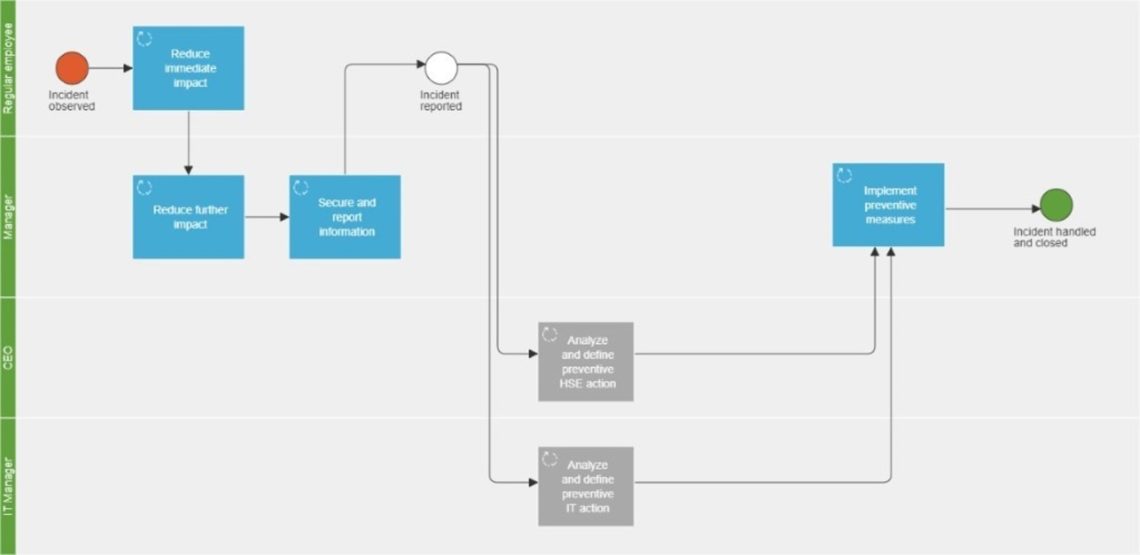
If you want to know more about incident reporting read our article ‘How to set up incident reporting’.
Estimated time spent: 2 hour
Add COVID-19 specific instructions and tasks to your process
Next, you need to ensure that COVID-19 specific instructions are included:
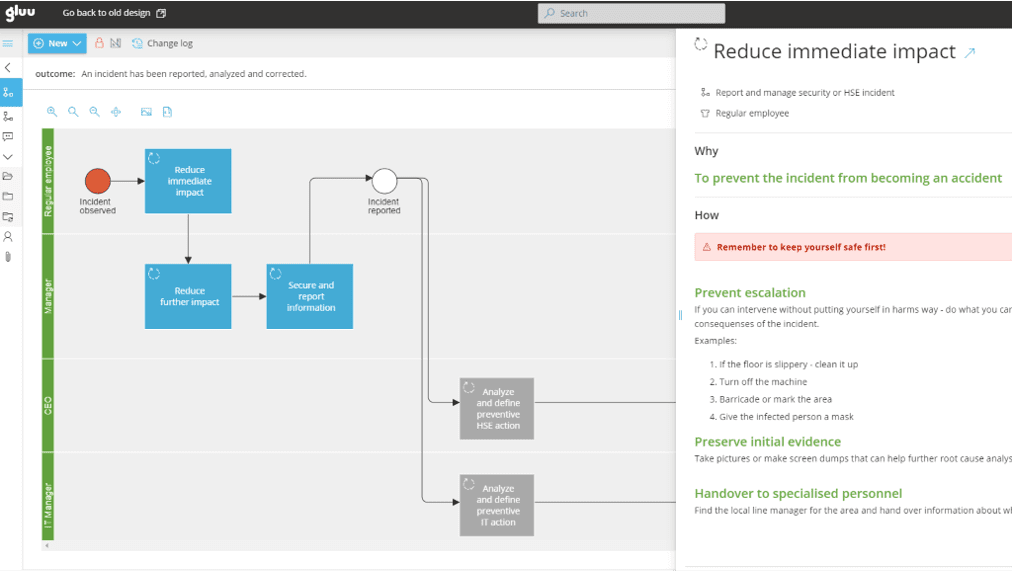
Next you may want to add some tasks that make your process flow measurable and tangible for the people that will be doing this. This way you can proceed through all the activities in your COVID-19 process and add the tasks that are important:
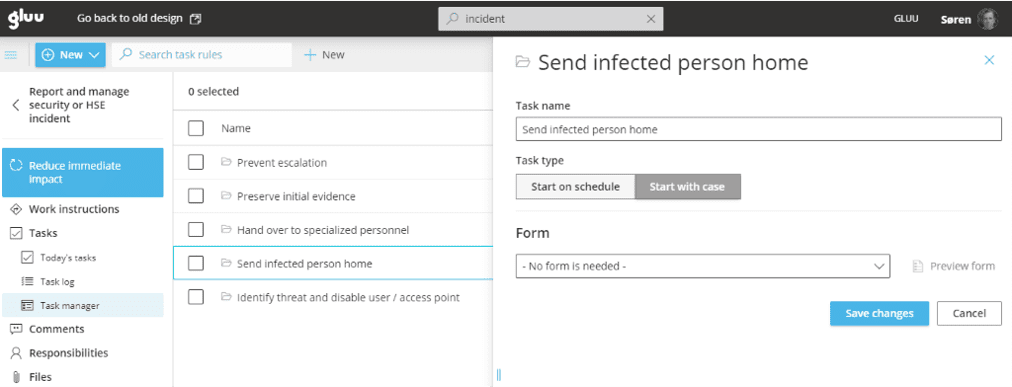
Estimated time spent: 1 hour
Now create a COVID-19 incident case flow
Once your process map is all done based on how you want to run it, you have instructions for each activity and tasks that will measure if the standard is followed, it is time to create a ‘case template.’ A case template is a variation of your incident process that can work specifically for COVID-19 cases. This way such incidents can have their own tasks and logic for when they will start.
You do this by putting each activity in the right order, reordering tasks, and setting some as ‘Critical’. Critical tasks let you start other tasks only once these are done. This means that everything happens in the right order.
In this example, I’ve created the following flow:
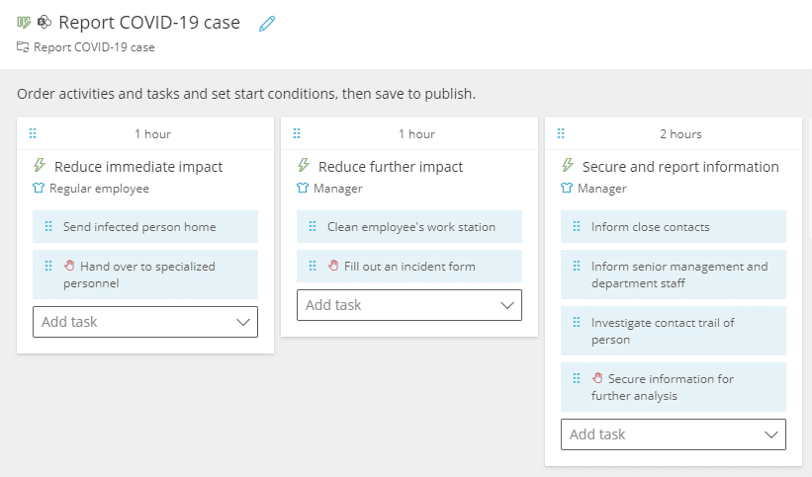
👉 Recommendation: The article “Managing New COVID-19 Cases Digitally” on Gluu is a brilliant resource for companies trying to navigate the COVID-19 pandemic. It provides helpful insights about the improtance of effectively managing procedures and processes in a digital environment during these challenging times. The piece extensively details an efficient method for tracking and recording coronavirus cases, helping organizations remain safe and compliant. I strongly recommend it to businesses seeking a more streamlined, digital approach towards dealing with the pandemic at the workplace.
Estimated time spent: 1 hour
Run your COVID-19 process
Now you’re ready to trial run your process. In our example, the management of a COVID-19 incident involves three roles: A regular employee (anybody in the organization, really), a manager, and possibly a specialist (if you have a Health & Safety manager, for instance).
You need to add some colleagues to these roles to test it.
Control each case
As people start new cases, you can track the status of each of the case:

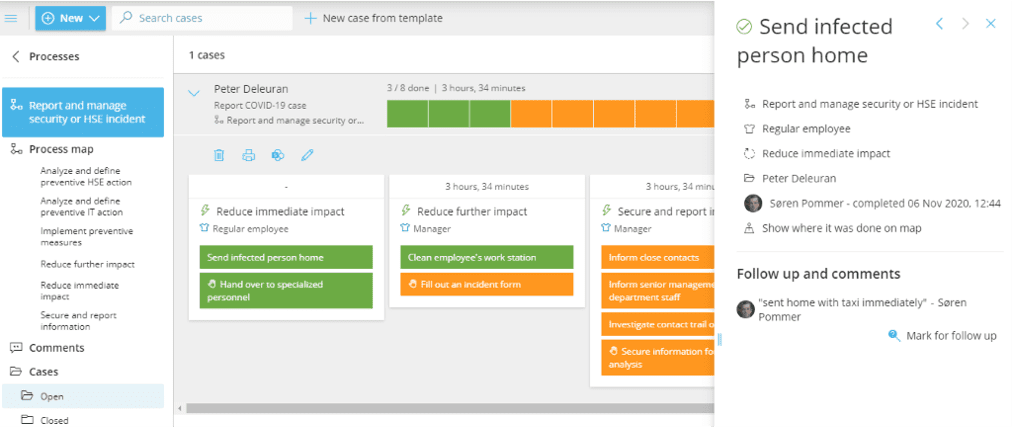
And if you need to report on the case you can quickly print a report with an exact status of each case:
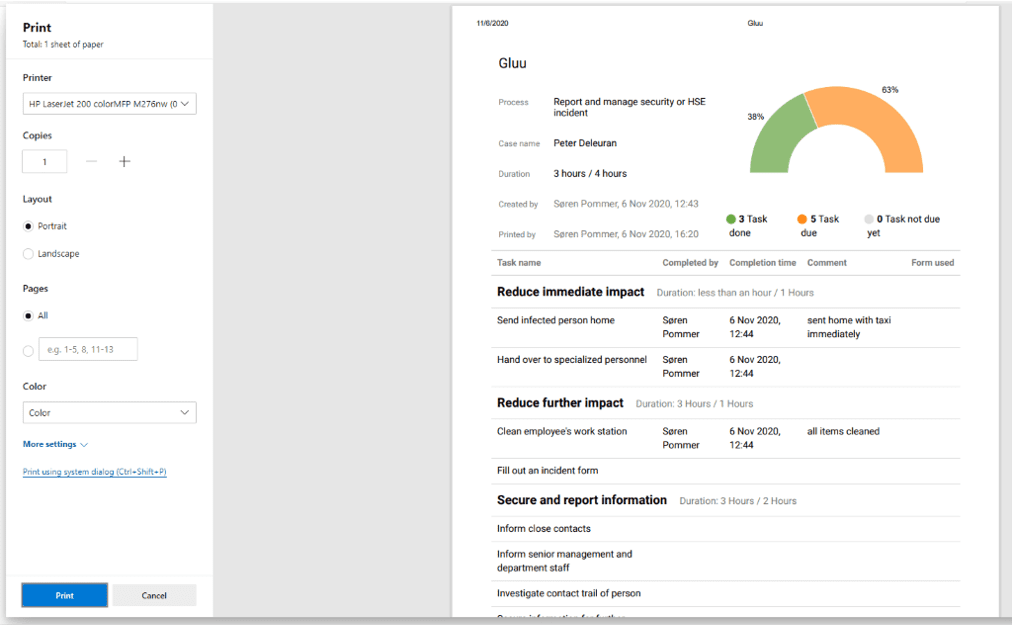
Managing changes and new guidelines
As you well know the guidelines that health authorities provide change often. So what do you do when you need to change your process? Then you simply go back to edit your flow, add new tasks and instruction, and inform your organization. This can be done in real-time and in minutes.
Why not try for yourselves? Just create a free 14-day trial and use the included incident management template to create your own.
👉 Recommendation: A must-read for businesses looking to effectively manage new COVID-19 cases using digital solutions. The piece provides a comprehensive guide on how to optimally leverage the power of tech innovations to streamline COVID-19 processes within organizations. It particularly focuses on risk assessment, rapid response, reporting, and learning, all critical steps in managing the ongoing pandemic. If you’re seeking practical, data-driven ways to boost your organization’s COVID-19 handling protocols, this article offers invaluable resources and strategies.
Conclusion
The article from Gluu outlines how businesses can utilize digital solutions to manage new COVID-19 cases within their organizations more effectively. It emphasizes on leveraging technology for risk assessment, quick response, accurate reporting, and continuous learning to manage the COVID-19 pandemic more efficiently. This article provides businesses with essential resources and strategies for improving their COVID-19 handling protocols with data-driven and practical solutions.
Frequently Asked Questions
The platform provides a variety of specific features geared towards managing new COVID-19 cases. These include real-time case tracking, notification systems for new cases, as well as a detailed patient dashboard which displays comprehensive personal and health information. In addition, there are tools to analyse data to identify hotspots, trends, and patterns. There is also a system in place for contact tracing to flag individuals who have been in contact with confirmed cases.
Ensuring stringent data security is a fundamental aspect of this digital platform. The platform utilises advanced encryption protocols to safeguard sensitive health-related information. Furthermore, strict access controls are in place so that only authorized personnel can access the data. Regular audits and security monitoring are conduct to continuously scrutinze any suspicious activities. In this way, the digital platform maintains a high level of data security while respecting patient privacy.
Prior to its launch, the digital platform underwent an extensive trial phase. Pilot tests were conducted in select areas to ensure the functionality and efficiency of the platform. The feedback received was overwhelmingly positive, with users lauding its user-friendly interface and responsiveness. The trial phase pointed to areas that needed fine-tuning and further enhancement. These improvements have since been implemented, leading to the refined platform that we have today.



